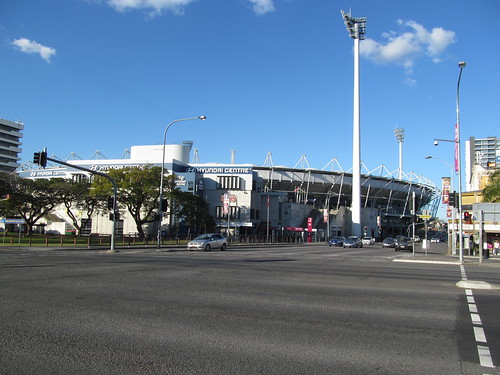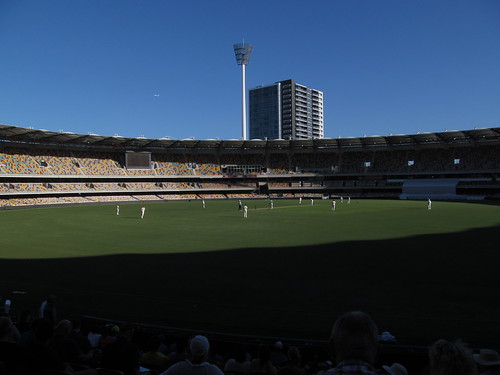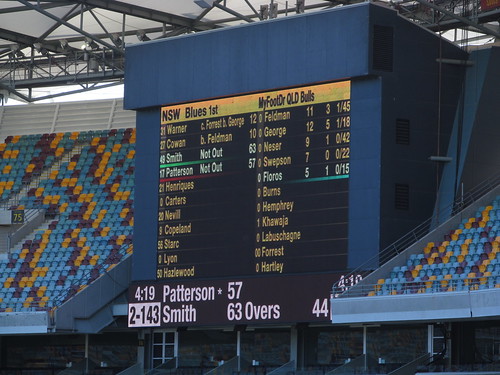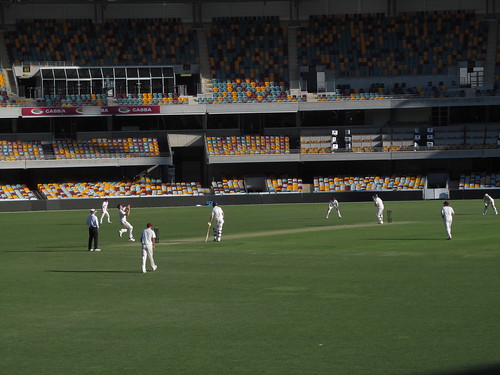Australia: Cricket
NOTE: The fifth day of the third test match between Australia and Pakistan began at 5:30 pm Tulsa time, Friday, January 6, 2017. You can listen online (free with registration) or watch the ball-by-ball description (no registration required) here. Australia finished its second and final innings late yesterday with a 464 run lead. Pakistan must either catch up to win (very difficult), or manage to keep batting until the end of the day for a draw (possible). UPDATE: Australia managed to get all 10 wickets within 80 overs, giving up only 244 runs. That's only three more runs than Australia gained for two wickets. Only one Pakistani batsman managed more than 50 runs. Final total: Australia 779, Pakistan 559.
NBC Sports Network (Cox Tulsa channels 317/1317) is airing ten KFC Big Bash League games this season, including semifinals and finals later this month. The next opportunity to watch is the Brisbane Heat vs. the Perth Scorchers, on January 11, 2017, 2:30 am Tulsa time, with a rebroadcast on January 12 at 11 am Tulsa time.
Imagine a variant on baseball:
- Instead of scoring a run when you pass home plate, you score a run every time you reach a base.
- Instead of four bases, there are only two.
- Instead of the base consisting of a square pad you have to step on to be safe, there's a line you have to cross.
- There's always one batter and one runner on first.
- The pitcher pitches six balls from first base to home plate. Then home plate becomes first base and vice versa, the batter becomes the runner and vice versa, and a different pitcher pitches six balls in the opposite direction from the previous 6.
- "Pitcher" is a misnomer. He can best to bounce and spin the ball off of the ground. Let's call him a bowler instead.
- There's no such thing as a foul ball.
- If you hit the ball, you don't have to run, if you don't think you have time to run to the other base before the ball comes back.
- Instead of standing beside home plate, the batter stands in front of a thing that looks like three croquet stakes next to each other, with two little wooden tops resting on top of them.
- Getting out involves someone catching a batted ball on the fly; a fielder hitting the croquet stake things with a ball, hard enough to knock the wooden top things off, while runners are between the lines; the bowler hitting the croquet stake/wooden top assembly with the ball, or the bowler hitting the batter's leg with the ball if the ball would otherwise have hit the croquet stake/wooden top things.
- Instead of an outfield wall, there's a rope, at least 225 feet from the batter. Hit a ball over it on the fly, you score six runs. Hit it over on the ground, you score four runs.
- If you hit a double or a home run, you get to keep batting, at least until it's time for the bowling to change direction.
- One team keeps batting until 10 of their 11 batters are out. That's an innings. Each team gets two inningses.
- You play for six hours a day, stopping a couple of times for lunch and snacks, for four or five days.
- No pinch hitters, no pinch runners, no substitutions (except for illness or injury).
- And if both sides haven't finished their inningses by the scheduled end of the game, it's a tie, no matter how big the lead.
This, then, is cricket.
I was delighted to hear that there would be a Sheffield Shield match at the Brisbane Cricket Ground while I was in town, and my schedule would allow me time to take in some of the match. Sheffield Shield is the name of the annual double-round-robin competition between state teams, and this four-day match would pit the Queensland Bulls against the New South Wales Blues. Better yet, there was no fee for admission, so I could watch as much as I had time for without feeling I'd wasted money on a ticket.
Sheffield Shield is just one level down from international competition (aka Test cricket), but levels of play aren't mutually exclusive the way they are in American baseball. A Shield team is more like a statewide all-star squad, and the team that competes in international tests is like the Olympic team. Steve Smith, captain for Australia, also captains the NSW Blues and plays for the Rising Pune Supergiants in the Indian Premier League. Other international players also play in Australia's Big Bash League, a shorter form of cricket. Smith was batting while I was there, and the Blues and Bulls combined included at least a half-dozen players that are also on the national team: Dave Warner, Usman Khawaja, Mitchell Starc, Josh Hazlewood, and Nathan Lyon.
The state teams and national team each have a panel of selectors who pick which players will take the field for the next match. After a string of losses, the selectors take as much heat, if not more, than the players. After Australia lost the first two test matches in a series of three against South Africa last month, the chairman of selectors resigned. A revamped board of selectors called up some new players, based on their performances in this season's Sheffield Shield, and the recharged Aussies managed to win the third and final test against South Africa, a series of one-day internationals against New Zealand, and the first test against Pakistan. Currently Australia is ranked second among the 10 nations that play test cricket, trailing India; the two teams will meet in a four-match series in India in February and March.
I said the match was held at the Brisbane Cricket Ground, but if you were to ask a local for directions using that name, you'd likely get a blank stare. At five syllables, that name, while technically accurate, is way too long for an Aussie to trouble himself to speak it in full. Locally, the stadium is known as The Gabba, which is short for Woolloongabba, the Brisbane district in which it's located.
There has been a cricket ground at the site of The Gabba since 1895, but the current 42,000-seat stadium is the product of a staged redevelopment from 1993 to 2005 that replaced historic grandstands and buildings with a round stadium, the sort of thing that American cities built in the US in the 1970s to house both baseball and football teams (e.g. Busch Stadium, Three Rivers Stadium, Riverfront Stadium). I heard a cricket commentator on the radio refer to the redeveloped Gabba as "soulless." It certainly lacks any sense of history.
Before the redevelopment, there was a grassy berm known as "The Hill" where rowdier fans could let loose, and kids could run and play:
The Gabba hill was a place where you could stretch out, relax, drink full strength beer, watch some cricket, or even have a sleep late in the day if you needed it. And for those seated in the stands, when the game out in the middle was meandering along, you could always rely on the hill to provide some entertainment....I remember sitting on the hill at the Gabba while my grandpop drank tallies and us kids played with an old bat and tennis ball.
The oval fits in between two major streets, but the stadium stands were a little too big. Rather than reroute the streets, the upper-levels of the stands overhang them.
On this October day in 2016, only one gate was open for the match. A stadium staffer handed me a roster of players and directed me to the handful of sections that were available. The ground-floor concourse looked the same as a US multipurpose stadium, except for the off-track betting parlor. A single concession stand offered soft drinks, hot dogs, chips (fries, that is), low-point beer, and mixed drinks. (They have pre-mixed cans of Bundaberg rum or Jack Daniels or Jim Beam and cola, diluted to 4.6-5.0% ABV, just a little stronger than 3.2 ABW beer.) Some sections were marked as no-alcohol zones.
Perhaps 200 fans were scattered around the open sections. The sky was cloudless. Qantas and Virgin Australia jets zoomed overhead on final approach to Brisbane airport several miles north.
The quiet was striking. No announcer on the PA system. No music between overs. Just conversation, interrupted by the crack of bat on ball and applause when someone hit for four or for six. The crowd rewarded a century -- a batsman reaching 100 runs -- with sustained applause and a standing ovation, even if it was a batter for the opposing team. Once in a great while, there'd be a cry of "howzat!" from the fielding team (the traditional way to appeal to the umpires to call a batter out), followed by a groan from the crowd in reaction to the umpire's decision. Over three separate visits to the stadium, I heard young tourists speaking French, middle-aged men discussing buying a television, train journeys, and the new female clerk at the 7-Eleven, a noisy, vulgar heckler (who was escorted out), and long-time cricket fans actually discussing the players and action on the field.
The scoreboards on either side of the stadium displayed the rosters for each team with batting and bowling stats for the current innings.
Cricket is a challenging sport for spectators. The closest seat in the stadium is nearly as far from the wicket (about 250 feet) as a Fenway Park bleacher seat is from home plate (just over 300 feet). With few exceptions, plays don't develop over time but are almost instantaneous: A ball is bowled, the batter strikes, the ball is caught or stopped, all in a matter of seconds. Unless you have very keen eyes, you're dependent on the reaction of the fielders, a signal from the umpires, or a change on the scoreboard to know what just happened. Watching on TV, where the cameras can zoom in on the action, and where you can watch instant replays and hear play-by-play commentary, makes the action easier to follow. The exceptions are boundaries, particularly when there's a chase to see if a fielder can stop the ball before it crosses the rope; and run-outs, when the batters are trying to stretch a hit into as many runs as possible -- a fielder throws the ball at the wicket to knock off the bails while the runner is between the lines.
The biggest challenge to drawing a crowd is the sheer length of the games. Unless you're retired, you just don't have time to watch a match that runs for six hours per day over four or five days. Cricket organizations have tried to adjust to modern tastes by playing day-night cricket, starting at 1 pm instead of 10 am, pushing the final session into the evening, under the lights (with a pink ball that's easier to see), and by offering shorter forms, like one-day internationals, where each team is limited to 50 overs (300 balls), or Twenty20 cricket, in which the limit is 20 overs (120 balls) a side, a game that can be finished in roughly three hours, the length of a longish baseball game. The KFC Big Bash League plays Twenty20 cricket in eight cities, one in each state capital plus a second team each for Melbourne and Sydney. Last year, the Brisbane Heat drew 29,353 fans on average, despite a 6th place finish. This past Tuesday, a match against the Sydney Sixers brought 32,371 fans through the turnstiles.
Compare that to 26,343 for the first day of the first test against Pakistan at the Gabba last month. As the match continued, attendance declined and then plummeted: 23,344 on day 2, 20,915 on day 3, 4,890 on day 4, and 2,593 on the final day. Australia had finished batting on day 3, and rain shortened day 4, but Pakistan finished strong and came close to catching up, only to be all-out early on day 5, when bad weather threatened again.
But long-time cricket fans worry that short-form cricket, which is becoming the norm for school matches, is ruining players for the traditional game. Twenty20 cricket puts a premium on swinging for the fences at every opportunity. In traditional cricket, patient shot selection is key to staying at bat and running up the score. If you hit twelve balls in a row on the ground and never budge from the crease, that's OK -- you've defended your wicket.
Traditional cricket adds more strategy to the game: The weather forecast, bowler fatigue, the changing condition of the ball and the pitch, the effect of sunlight, shadow, and stadium lights, the time remaining, all play into the captain's decisions about whether to bat or defend, when to "declare" (end an innings early, before 10 wickets have fallen), and whether to require a follow-on (a team leading by 200 or more runs after the first innings can require the trailing team to hit first in the second innings, increasing the likelihood that the match will be completed in the allotted time, avoiding a draw, and possibly avoiding the need to bat a second time).
The three formats for cricket are different enough that separate statistics are kept for each, even though many players participate in all three. Sheffield Shield matches are classified alongside Test matches, as they only differ in running four days instead of five.
I became fascinated enough with the sport that I returned to the Gabba for a later day of this match (stopping in to watch a few overs while my laundry was drying in a nearby laundromat) and again with my family a month later, to see Queensland against South Australia. I watched New Zealand wrap up its successful home series against Pakistan on TV and enjoyed listening to the Australia-New Zealand series of One-Day Internationals on the radio, as Mitchell Starc, a solid bowler and batsman, knocked one six after another. At the moment, I have to settle for listening to the Pakistan test series online, via cricket.com.au.
MORE: I found these links helpful for understanding the game. It's an iterative process, like learning a new language. Read a bit, watch a match, read some more, watch with more understanding.
Grammar:
- Cricket Explained: An American Viewpoint, by Jeff Tucker
- Cricket for Baseball Fans, by Cheryl Morgan
Dialectic:
- BBC Guide to Cricket Fielding Positions: Click the diagram to learn where mid-off, fine leg, deep cover, and third man are, and why they matter
- Understanding Cricket Statistics, by Cheryl Morgan: What's meant by "strike rate," "economy rate," and other frequently cited stats; how charts are used to illustrate game play
Rhetoric:
- Understanding Cricket Commentary, by Cheryl Morgan: Helpful for understanding how radio commentators explain bowling technique, where the fielders are, and where the ball goes when its hit
MORE:
A dad took his six-year-old son to see the Pakistan / Australia match at the Gabba. It wasn't the happy family outing he had expected:
When finally arriving at the correct gate, we went through the bag search where my son was told in certain unfriendly terms his tiny little pokemon balls had to be confiscated because we might throw them onto the pitch. (As any father does, I had told him earlier in the day to pack a few toys into his bag to keep him occupied if necessary, so he collected his latest favourites).I argued that he would be devastated to lose custody of these, even if it was just for a few hours. In the office, he broke down, and he's not a cry baby. He was well aware of the previous exchanges and begged and pleaded and promised he was not the slightest bit interested in throwing his toys away. I was ready to erupt, but I had paid my money and was damned if I'd give these narrow minded people the satisfaction of their assumed pathetic power and walk away. So we relented as I held my temper and muttered under my breath about stupid rules and family friendly outings, then found our assigned seats which were grossly sticky and the area covered in trash and shite. Unfortunately, and because of the delays, the second we got there, Australia declared, so we were left in the stink of squashed food and stale beer while the reverse sun beat down and my confused and overwhelmed little boy just wanted to be anywhere else and cried on my shoulder....
Play resumed eventually, and we got down to discussing what was happening on the pitch. That didn't last long as the bogans returned from their local piss-ups and soon took over. Boredom quickly set in as no wickets fell in the first ten deliveries and so it was decided our section would start the dreaded Mexican wave. Non-participation was met with beery boo s and foul, hairy brown-eyes. I can t report that we particularly enjoyed being repeatedly splattered with beer whilst not being able to actually watch the cricket we came to see. The language was disgusting. The attitude deplorable. The abuse obscene. Racist innuendo was applauded. It was a yobbo-fest. And it was my son that was singled out on entry. What a farce! ...
I paid money to watch cricket, not to be a minority that wasn't interested in it. So we left, never to return, ever. Generations of my family have been cricket followers, and I spent much of my summers at the SCG as a kid, but my intolerance of the crowd spectacle means that it probably ends here, for no other reason than when the game comes to town, it attracts the majority of Australians who just can t hold their piss.
1 TrackBacks
Listed below are links to blogs that reference this entry: Australia: Cricket.
TrackBack URL for this entry: https://www.batesline.com/cgi-bin/mt/mt-tb.cgi/7923
If you read my earlier entry about cricket in Australia, you're likely champing at the bit, wondering where you can see this high-scoring sport close to home. In the month of January, your best opportunity is while seated on your sofa. NBC Sports Netwo... Read More



